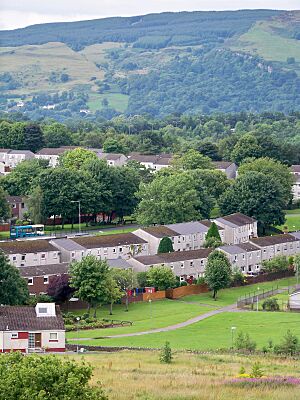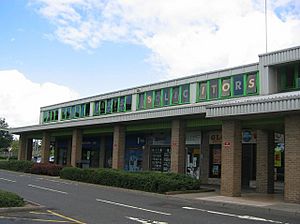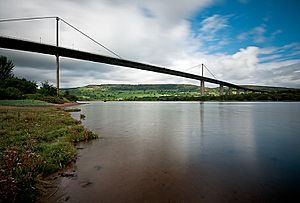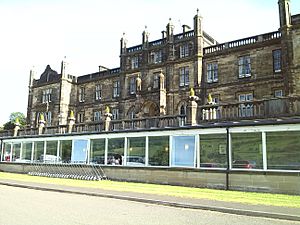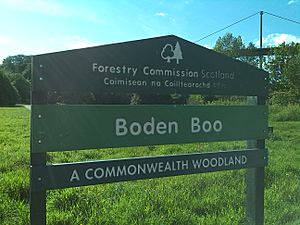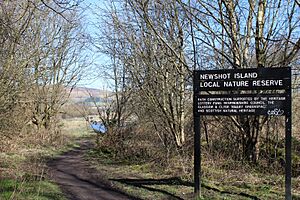Erskine facts for kids
Quick facts for kids Erskine
|
|
|---|---|
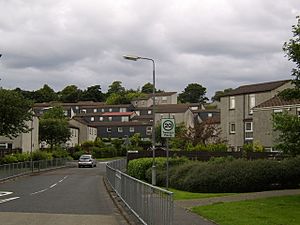 Parksail |
|
| Population | 15,010 (2020) |
| OS grid reference | NS460667 |
| Council area | |
| Lieutenancy area | |
| Country | Scotland |
| Sovereign state | United Kingdom |
| Post town | ERSKINE |
| Postcode district | PA8 |
| Dialling code | 0141 |
| Police | Strathclyde |
| Fire | Strathclyde |
| Ambulance | Scottish |
| EU Parliament | Scotland |
| UK Parliament |
|
| Scottish Parliament |
|
Erskine (pronounced like ER-skin) is a town in Renfrewshire, Scotland. It is located in the western part of Scotland, on the southern side of the River Clyde. The Erskine Bridge connects the town to Old Kilpatrick on the river's north bank.
Erskine is a commuter town, meaning many people live there but travel to nearby cities like Glasgow for work. It is close to Bishopton to the west and Renfrew, Inchinnan, Paisley, and Glasgow Airport to the south. Erskine was once a small village. However, it has grown a lot since the 1960s, with its population now over 15,000 people. In 2014, Erskine was even named one of the best places to live in Scotland!
Contents
- Erskine's Past: A Look at Its History
- Where is Erskine? Understanding its Geography
- What Does Erskine Offer? Its Economy and Services
- Famous Places in Erskine: Landmarks to See
- Getting Around Erskine: Transport Links
- Learning in Erskine: Schools and Education
- Famous People from Erskine
- Images for kids
- See also
Erskine's Past: A Look at Its History
Archaeologists have found proof that farming happened in the Erskine area as far back as 3000 BC. People have lived here since 1000 BC. The first time Erskine was mentioned in writing was in 1207. This was when the church of Erskine was confirmed by Florentius, who was the Bishop of Glasgow.
The land around Erskine belonged to Henry de Erskine in the 13th century. Later, Sir John Hamilton of Orbiston owned it in the 17th century. In 1703, the Lords Blantyre took over the estate. By 1782, Erskine had twelve houses and a church. A new church was built then, and it is still used today. Many workers moved to the area between 1836 and 1841. They came to help build the Inverclyde railway line. In 1900, William Arthur Baird became the owner of the land. He inherited it from his grandfather, Charles Stuart, 12th Lord Blantyre.
In the late 1700s, Erskine was a very small settlement called a hamlet. Stone quays were built to help the Erskine Ferry cross the river. This ferry connected Erskine to Old Kilpatrick and Dunbartonshire. It replaced an older river crossing that had been there since medieval times. As more industries and buildings grew nearby, Erskine slowly became a village.
By 1961, about 3,000 people lived in the small church community. The Renfrewshire County Council then made a plan to develop the town. This plan, called the "New Community" plan, involved building many new homes. Building started in 1971, with both private and rented houses. This caused the town's population to grow by about 10,000 people.
In the 1990s, Erskine became a popular place for people who commute to work. Larger and more expensive houses were built to attract wealthier buyers. People have been worried about the town growing too much. Because of this, several plans for new large housing developments have been stopped. One main reason is that the town only has one secondary school.
Where is Erskine? Understanding its Geography
Erskine grew a lot in the 1970s with new housing association homes. Since then, many private houses have also been built. In the 1980s, Erskine became a great place to live. This was because of its good location and easy access to main roads and the M8 Motorway. This led to a big increase in property building in the 80s and 90s.
Most of the housing association homes are in areas like Bargarran, North Barr, and Park Mains. Private houses are mostly in the western part of town. These areas include Garnieland, Flures Drive, Hawthorn, Parkvale, Parkinch, St. Annes, and West Freelands. Many home builders, such as Miller Homes, Avonside, and Cala, have built houses here.
The town is next to several other towns and villages. Some are separated by countryside.
 |
Bishopton | Old Kilpatrick | Clydebank |  |
| Kilmacolm | Renfrew | |||
| Houston | Paisley | Inchinnan |
What Does Erskine Offer? Its Economy and Services
The Bridgewater complex in Erskine has many businesses. These include shops and places for fun. You can find supermarkets, a tanning salon, a dentist, a bakery, and a butcher. There are also fish and chip shops, takeaways, a pub, a Chinese restaurant, and an optician. Other services include a chemist, a doctor's surgery, a hardware store, a hair salon, and a bank. The complex also has a swimming pool, a funeral directors, and a public library.
Smaller shopping areas are in Bargarran, Mains Drive, and Park Glade. These areas have a few shops, restaurants, and a community center.
Near the river, there is an office building for a logistics company. The Erskine Bridge Hotel is also on the banks of the Clyde. A short distance up the river is the Pandamonium Play Centre. Erskine also has two private golf clubs: the Erskine Golf Club and the Mar Hall Hotel and Golf Course.
The area also has two newer sports facilities. These are the Erskine Community Sports Centre and the Astroturf pitch at Park Mains High School.
Famous Places in Erskine: Landmarks to See
Erskine Bridge: A Major Crossing
The Erskine Bridge is a very tall bridge that crosses the River Clyde. It is the furthest west point where you can cross the river. After the bridge, the river gets much wider and becomes the Firth of Clyde estuary.
Erskine House: From Home to Hotel
Erskine House was built between 1828 and 1845. It was designed by Sir Robert Smirke, who also designed the British Museum. During the First World War, it became a hospital for soldiers and sailors who had lost limbs. Today, it is the 5-star Mar Hall Hotel. Its name reminds us that the estate was once owned by the Earl of Mar.
Erskine Hospital: Helping Veterans
Erskine is home to the Erskine Hospital. This hospital provides long-term care for veterans of the British Armed Forces and their spouses. It also has a day center and new homes for younger veterans. The charity started in 1916 as the Princess Louise Scottish Hospital for Limbless Sailors and Soldiers. This was because many soldiers lost limbs in the First World War.
Since then, it has helped British ex-service people from all wars. It has become one of the largest facilities for ex-service members in Scotland. The charity has two units in Erskine and other units in Glasgow and Edinburgh. The British Royal Family has strong connections with the charity. Prince Charles is its patron. He opened the main unit, called Erskine Home, in 2000. Princess Anne has also opened different units for the charity.
The charity holds many events throughout the year to raise money. These include a motorbike meet, a military-themed ball, and Christmas fairs. The charity needs to raise £10 million every year to run its services. They also welcome volunteers from the public.
Boden Boo: A Woodland Escape
Underneath the Erskine Bridge is a woodland area called Boden Boo. It has about 2 miles (3.2 km) of walking trails, picnic spots, and views of the River Clyde. It's a great place for walking and cycling. The Erskine Beach is also located here. Forestry and Land Scotland looks after this area.
Newshot Island: A Nature Haven
Newshot Island Nature Reserve is a salt marsh that reaches into the River Clyde. Even though it's called an island, it's actually a peninsula now. It was formed from silt left over when the river was made wider and deeper in the 1930s. This silt connected the island to Erskine. The nature reserve is an important place for many migratory birds. They use it as a feeding and resting spot when traveling from places like North America, Siberia, and West Africa.
Getting Around Erskine: Transport Links
Glasgow Airport is only 4 kilometers (2.5 miles) south of Erskine. This makes it easy for people to travel by air.
The Old Greenock Road connects Erskine to the M8 motorway, the Erskine Bridge, and Bishopton. The A726 road also connects to the Erskine Bridge, which then links to the M898 motorway for further travel. The A726 road goes through the center of Erskine and is the main road to Paisley.
McGill's Bus Services operates buses in Erskine. These buses go to Glasgow, Paisley, Renfrew, Inchinnan, Clydebank, Glasgow Airport, and Bishopton. There are also plans to connect Erskine to Glasgow with a new metro line as part of the proposed Clyde Metro Project.
Learning in Erskine: Schools and Education
The main secondary school in Erskine is Park Mains High School. It is the largest school in Renfrewshire and one of the biggest in Scotland, with up to 1,400 students. It is a non-denominational state school, meaning it is not linked to a specific religion. For Roman Catholic state education, students in Erskine go to Trinity High School in nearby Renfrew.
Erskine has five primary schools. All are state schools. Rashielea, Bargarran, and Barsail Primary Schools provide non-denominational education. St John Bosco and St Anne's Primary Schools provide Roman Catholic education.
Famous People from Erskine
- John McArthur, a general during the American Civil War.
- John Smeaton, who helped stop terrorists during the Glasgow Airport attack.
- Marcus Campbell, a snooker player.
- Stevie Jackson, a guitarist for the band Belle & Sebastian.
- Blair Spittal, a footballer for Partick Thistle.
- Maurice Malpas, a former footballer for Motherwell and Dundee United, who also played for Scotland.
Images for kids
See also
 In Spanish: Erskine para niños
In Spanish: Erskine para niños



